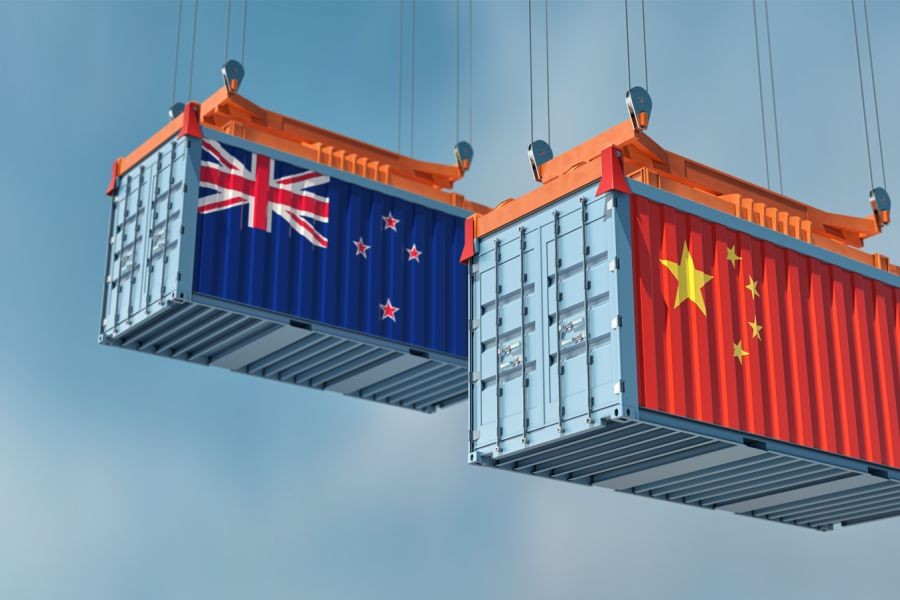In the ever-evolving landscape of global trade, New Zealand's economic ties with Asia have remained a pivotal force in shaping the nation's economic trajectory. As a management consultant, understanding these dynamics is crucial for advising clients on strategic decisions. While many are aware of the basic trade relationships, there are nuances and lesser-known aspects that significantly impact New Zealand's economy. This article delves into ten surprising facets of New Zealand's economic ties with Asia, offering insights and actionable strategies for businesses looking to optimize their operations and growth strategies.
When most New Zealanders think about Asia, they picture tourism, education, or trade in goods like milk powder and timber. But New Zealand’s economic ties with Asia go much deeper—and are far more influential—than many realise.
From high-tech investments to quietly negotiated trade diplomacy, Asia has become an indispensable economic partner that shapes everything from our job market to our geopolitical strategy. In this article, we’ll explore 10 lesser-known truths about these vital ties—and what they mean for New Zealand’s future.
1. Asia Buys Over 50% of New Zealand’s Total Exports
Asia isn’t just a trading partner—it’s the trading partner. More than half of New Zealand’s total exports now go to Asia, led by China, Japan, South Korea, and ASEAN nations like Indonesia and Vietnam. Key exports include:
Dairy (especially infant formula)
Meat and wool
Wine and kiwifruit
Timber and forestry products
Why it matters:
New Zealand’s economy is increasingly dependent on Asia’s consumer demand. A slowdown in China or tightening regulations in Southeast Asia can send ripples through Kiwi farms, factories, and shipping hubs.
2. China Isn’t the Only Game in Town
While China remains our largest trading partner (around $40 billion in total two-way trade), New Zealand’s trade diversification strategy has been quietly paying off.
Japan: Significant investor in infrastructure and automotive industries.
South Korea: Major tech and engineering partner.
India & Indonesia: Rising stars in service exports and student flows.
Emerging fact:
Vietnam recently overtook the UK as one of NZ’s top 10 trading partners. And bilateral trade with Malaysia and Thailand continues to grow under the ASEAN-Australia-New Zealand Free Trade Area (AANZFTA).
3. Asian Investment Is Reshaping Kiwi Infrastructure
Asian companies are increasingly investing in New Zealand’s long-term infrastructure—from ports to power.
Examples:
Chinese-owned companies have invested in real estate and logistics (though recent government restrictions have curbed some of this).
Japanese firms are involved in clean energy partnerships.
Korean capital is behind several smart-city projects and data centres.
Impact:
These investments create jobs, stimulate regional development, and bring high-tech expertise. But they also raise questions about foreign control over strategic assets.
4. Asian Students Fuel New Zealand’s Education Economy
In 2019, before the COVID-19 disruption, international education was worth over $5 billion, making it NZ’s 4th-largest export sector. Asian students accounted for over 75% of all international enrollments.
China, India, and South Korea dominate university enrollments.
Vietnam, Japan, and Thailand are growing in English-language and vocational sectors.
Why it’s more than tuition:
These students often stay and become part of the workforce, boosting NZ’s knowledge economy and long-term tax base.
5. Food Security in Asia Depends on New Zealand
Asia’s rapidly urbanising middle class is concerned about food safety, traceability, and quality—areas where New Zealand excels.
NZ’s pasture-raised livestock and clean-green image are prized in Asia.
The country is a strategic food partner in discussions around food supply chain resilience.
Case Study:
During the COVID-19 pandemic, NZ worked closely with Singapore and Japan to keep food exports flowing, highlighting its role as a trusted partner in regional food security.
6. Free Trade Agreements with Asia Give NZ a Global Edge
New Zealand has more high-quality FTAs with Asian countries than most of its OECD peers. These include:
China–NZ FTA (the first China FTA with a developed country)
CPTPP (Comprehensive and Progressive Agreement for Trans-Pacific Partnership)
AANZFTA
RCEP (Regional Comprehensive Economic Partnership)
Benefits include:
Tariff reductions
Market access for services
Legal protections for investors
Simplified rules of origin
Fun fact:
NZ played a leading diplomatic role in shaping the CPTPP after the US pulled out, enhancing its credibility across Asia.
7. Asia Is a Major Tech and IP Collaborator
Beyond trade, New Zealand is increasingly collaborating with Asia on innovation, especially:
Agri-tech: Partnerships with South Korea and Japan on climate-resilient farming.
Biotech: Joint ventures with Singaporean and Chinese firms.
Film and Creative Industries: Korean and Japanese studios co-producing with Kiwi firms.
Trend to watch:
NZ startups are now targeting Asian capital markets, especially in Singapore and Hong Kong, for scale-up funding.
8. Tourism from Asia Is Bouncing Back Differently
While Chinese visitor numbers haven’t fully rebounded post-COVID, other Asian markets are stepping in.
India and the Philippines are growing fast as outbound travel markets.
Thailand, Malaysia, and Vietnam offer long-stay visitors who combine tourism with study or work.
Shift in strategy:
Tourism NZ is now promoting niche experiences like Māori culture, eco-tourism, and luxury wellness retreats to appeal to Asia’s affluent travellers.
9. Asia’s Influence on Kiwi Pop Culture Is Surging
Economic ties aren’t just about goods and money—they also shape identity. You can see Asia’s influence in:
Food: Sushi, ramen, pho, and bubble tea are now mainstays in every Kiwi city.
Fashion & Beauty: K-pop, Korean skincare, and Japanese minimalism.
Tech Use: Social media habits in NZ increasingly mirror Asian platforms like TikTok (from China) and LINE (popular in Japan/Thailand).
Reality check:
As the demographics shift, young New Zealanders are growing up deeply connected to Asia—socially, economically, and culturally.
10. Future Workforce Shortages May Be Solved by Asia
With an ageing population and skills shortages in sectors like healthcare, engineering, and IT, New Zealand is increasingly turning to Asia.
Nurses and aged-care workers from the Philippines and India.
Engineers and tech experts from China and Malaysia.
Hospitality and tourism workers from Thailand and Vietnam.
Hard truth:
Without structured migration and recognition of foreign qualifications, NZ could lose its competitive edge in attracting skilled Asian talent.
The Unseen Backbone: Agricultural Trade
While many focus on technology and services, agriculture remains a cornerstone of New Zealand’s exports to Asia. In 2022, New Zealand exported agricultural goods worth NZD 23 billion to Asian markets (Stats NZ). Dairy and meat products are in high demand, particularly in China, which accounts for 32% of these exports. Businesses can leverage this demand by ensuring high-quality standards and sustainable practices, which are increasingly valued by Asian consumers.
The Quiet Rise of Tech Exports
Tech exports from New Zealand to Asia have grown by 40% over the past five years (MBIE). This growth is driven by software services and fintech innovations. For example, Xero, a New Zealand-founded company, has successfully expanded into Asian markets by tailoring its accounting software to meet local needs. This highlights the potential for Kiwi tech firms to tap into Asia’s burgeoning digital economy.
Educational Exchanges: A Cultural and Economic Bridge
Educational ties between New Zealand and Asia are robust. In 2023, over 30,000 students from Asia enrolled in New Zealand institutions, contributing approximately NZD 1.5 billion to the economy (Education New Zealand). These exchanges not only boost the economy but also foster long-term cultural and business ties, offering businesses a unique opportunity to build networks across Asia.
The Impact of Free Trade Agreements
New Zealand’s Comprehensive and Progressive Agreement for Trans-Pacific Partnership (CPTPP) with Asian countries has opened new avenues for trade. The agreement has resulted in tariff reductions, increasing competitive advantages for New Zealand exporters. Companies should stay informed about these agreements to maximize their benefits and navigate any regulatory changes effectively.
Tourism: Beyond the Usual Suspects
While China and Japan are well-known sources of tourists, countries like Thailand and Indonesia are emerging as significant contributors to New Zealand’s tourism sector. In 2022, visitors from these countries increased by 25%, according to Tourism New Zealand. This shift requires a reevaluation of marketing strategies to cater to diverse cultural preferences and expectations.
Real-World Case Study: Fonterra’s Expansion in Asia
Problem: Fonterra, New Zealand’s dairy giant, faced stiff competition in the Asian market, particularly in China, where domestic producers were gaining ground.
Action: Fonterra implemented a localization strategy, partnering with Chinese companies to enhance distribution channels. They also introduced product innovations tailored to local tastes.
Result: Within two years, Fonterra’s market share in China increased by 15%, with a revenue growth of NZD 300 million.
Takeaway: Localization and strategic partnerships are crucial for success in competitive Asian markets.
Common Myths & Mistakes
- Myth: Asia is a homogeneous market. Reality: Each country has unique consumer behaviors and regulatory environments that require tailored approaches.
- Myth: Only large corporations can succeed in Asia. Reality: SMEs, with their agility, can effectively enter niche markets if they leverage local insights and partnerships.
Avoiding the Mistakes Others Already Made
Case Study: The Over-Reliance on a Single Market (China)
In 2020, Australia faced severe economic retaliation after its government called for an investigation into COVID-19’s origins. Key exports like barley and wine were targeted by China. New Zealand observed and learned, quietly doubling down on diversification across ASEAN and India.
Lesson for Kiwis:
While China is vital, over-dependence is risky. Smart diplomacy and regional diversification are crucial for long-term economic resilience.
The Role of E-commerce
The growth of e-commerce in Asia presents a lucrative opportunity for New Zealand businesses. Platforms like Alibaba and Shopee offer access to millions of consumers. New Zealand companies must optimize their digital presence and logistics to capitalize on this trend, ensuring they meet the expectations of tech-savvy Asian consumers.
Future Trends & Predictions
By 2028, Asia's middle class is expected to reach 3.5 billion, accounting for 65% of the global middle-class population (Brookings Institution). This demographic shift will drive demand for premium products, including New Zealand’s high-quality food and beverages. Businesses should focus on branding and storytelling to connect with these consumers emotionally.
Conclusion
New Zealand's economic ties with Asia are multifaceted, offering a wealth of opportunities for businesses that can navigate these complexities. By understanding and leveraging these ten lesser-known aspects, Kiwi companies can position themselves for sustained growth in the Asian market. What’s your next move? Are you ready to explore these opportunities and expand your business horizon in Asia? Share your insights below!
People Also Ask
- How does New Zealand's trade with Asia impact local businesses? New Zealand businesses see increased revenue opportunities and market expansion, driven by Asia’s demand for quality goods and services.
- What are the biggest misconceptions about New Zealand's trade with Asia? One myth is that only large corporations can succeed. In reality, small businesses with niche products have significant opportunities.
- What strategies help New Zealand companies succeed in Asia? Localization, strategic partnerships, and digital commerce optimization are key strategies for successful market entry and growth.
- What upcoming changes could affect New Zealand's trade with Asia? By 2026, shifts in consumer preferences towards premium products could reshape market strategies.
- Who benefits the most from New Zealand's trade with Asia? Agricultural exporters, tech firms, and educational institutions are among the key beneficiaries of these economic ties.
Related Search Queries
- New Zealand trade agreements with Asia
- Agricultural exports from New Zealand to Asia
- Impact of CPTPP on New Zealand economy
- New Zealand tech companies in Asia
- Asian tourism in New Zealand
- Future of New Zealand-Asia economic relations
New Zealand’s economic future is intertwined with Asia—not just in trade but in education, migration, technology, and even identity. The relationship is no longer just transactional—it’s transformational.
As Daniel Chyi, co-founder of Vidude.com, puts it:
“To thrive in the next decade, Kiwis need to stop thinking of Asia as ‘over there.’ It’s right here in our markets, our classrooms, our code, and our stories. Platforms like Vidude are about helping New Zealanders share those stories—visually, authentically, and globally.”


































LavadaJaff
5 months ago